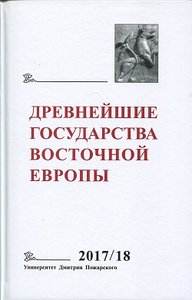The Earliest States of Eastern Europe. 2017–2018: Early forms and functions of writing / Editor of the volume T.V. Guimon. Moscow: Dmitry Pozharsky University, 2019

The next volume of the almanac "The Earliest States of Eastern Europe" is devoted to the early forms and functions of writing in the societies of Antiquity and the Middle Ages. The central problem of the volume - writing and the formation of statehood is considered on the material of a number of societies of Antiquity and the Middle Ages, including Old Rus'. Other subjects related to the early functions of writing and the relationship between oral and written practices at different stages of the formation of written culture are also analyzed; sources are researched and published that are fundamentally important for understanding the early history of writing in a number of regions. The book is intended for a wide range of historians, philologists and specialists in related disciplines, as well as for all those who are interested in the history of writing and, more broadly, in the history and culture of Antiquity and the Middle Ages.
Table of contents
- T. V. Guimon - Preface - 5-9
- I. S. Arkhipov - On the use of “check marks” in cuneiform writing - 10-21
- I. E. Surikov - Statehood and Writing in Ancient Greek World: Some Aspects of Correlation of the two Spheres - 22-40
- M. V. Skrzhinskaya - The Role of Written Documents in the Life of Antique States of North Black Sea Coast - 41-61
- A. V. Korolenkov - The Burning of the Unwanted Enemies’ Letters in Rome and Clementia: from the Republic to the Empire - 62-70
- V. A. Arutyunova-Fidanyan - State and Early Historical Writing in Armenia: Aspects of Interaction - 71-85
- I. E. Ermolova - The Hunns and the Writing - 86-94
- A. P. Gavrilov - Signs on Objects of the Culture of Ryazan-Oka Burial Sites - 95-103
- V. V. Tishin - A Socio-Political Background of the Origin of Old Turkic Runic Writing - 104-127
- R. P. Khrapachevsky - The Mongolian Writing as a State-Forming Factor for the Polity of Genghis Khan and his Successors - 128-139
- E. A. Melnikova - Runic Writing in the Periphery of the Scandinavian World. Part 1: the Islands of the North Atlantic - 140-168
- T. N. Jackson - From Oral Communication to Written: Situation in Medieval Norway in the Light of Icelandic Sagas - 169-195
- E. V. Litovskikh - The Workshop of Sturla Þorðarson: oral and written sources of Sturlubók - 196-215
- T. V. Guimon - Prince Vladimir and Writing - 216-240
- M. M. Drobysheva - The Historiography of Old Rus Wall Graffiti (the 11th–14th centuries) - 241-281
- S. M. Kashtanov, L. V. Stolyarova - Mstislav’s Charter: Problems of Origin - 282-330
- V. I. Matuzova - Crusading Ideology in the Writings of the Teutonic Order in Prussia in the 13th and 14th centuries - 331-346
- A. I. Hruša - Justice for the Lord: the Process of 1467 in the Context of Socio-Cultural Changes in the Grand Duchy of Lithuania in the Second Half of the 15th Century - 347-367
- D. E. Mishin - The Middle Persian Text Abar ēwēnag-i-nāmag-nibēsišnīh (How to Write Letters) - 368-382
- T. M. Kalinina - Ibn al-Nadim’s Fihrist (the 10th Century) on Writing and Script of Some Peoples of Eastern and Western Europe - 383-405
- O. A. Makushnikov, E. A. Melnikova - A Finger-Ring with a Runic Inscription from Karavyshen’ Medieval Settlement (Gomel Region, Belarus) - 406-421
- A. D. Scheglov - The Prosaic Chronicle: a Monument of Swedish Late Medieval Historical Thought - 422-442
